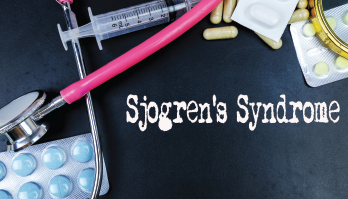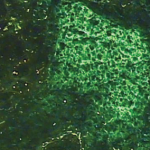
Papa Annur / shutterstock.com
An antibody previously un-recognized in patients with Sjögren’s syndrome may shed new light on the pathophysiology of one of the most troubling and disabling symptoms in many of these patients. Investigators at Johns Hopkins University, Baltimore, found the anti-calponin 3 antibody had a high specificity for Sjögren’s syndrome, particularly among patients with neuropathies.1
“There is interest in defining biomarkers of neuropathic pain in patients with Sjögren’s syndrome with neurological complications, and this has traditionally been hampered by the fact that these patients tend to very tenaciously have seronegative disease,” says the study’s lead author, Julius Birnbaum, MD, MHS, assistant professor of medicine and neurology, and director of the Johns Hopkins Jerome L. Greene Sjögren’s Syndrome Center at the Johns Hopkins University School of Medicine in Baltimore. “That is why we’re excited that we found a trend toward one unique specificity,” he says.
New Target for Antibody Specificity
Dr. Birnbaum and colleagues pursued a novel paradigm by immunoblotting patient serum against lysates from rat dorsal root ganglia (DRG). Dr. Birnbaum explained that antibodies against the DRG are relevant in patients with Sjögren’s syndrome because the DRG have been implicated in various autoimmune neurological disorders. They identified one novel antibody that was specific for the DRG: anti-calponin 3.
“Anti-calponin 3 was known to be an actin-binding protein that has been defined in cells with muscle tissue as well as the central nervous system, but has not been previously recognized to be expressed in the peripheral nervous system,” Dr. Birnbaum says.
Of 209 patients with Sjögren’s syndrome in the study, the researchers detected anti-calponin 3 antibodies in 23 (11%). When looking at patients with other types of autoimmune rheumatic diseases, they found the antibodies in 12 (8.7%) of 138 patients with systemic lupus erythematosus, in seven (5.1%) of 138 patients with myositis, in three (6.8%) of 44 patients with multiple sclerosis and one (2.2%) of 46 healthy controls.
‘The potential pathogenesis of underlying neuropathies in Sjögren’s syndrome might be somewhat indirect & targeted against perineuronal satellite cells & not the underlying DRG neuron.’—Dr. Birnbaum
Specificity in Patients with Neurologic Disease
To look for the frequency of anti-calponin 3 antibodies in patients with neurologic disease, the investigators divided the patients with Sjögren’s syndrome into three subgroups: those with no evidence of neuropathies (n=99), those with underlying neuropathies (n=39) and those with neuropathic-type pain without neuropathies (n=71). The patients with underlying neuropathy had a higher frequency of anti-calponin 3 antibodies (18%) when compared with healthy controls (2.2%). This finding, Dr. Birnbaum says, shows that anti-calponin 3 is enriched in Sjögren’s syndrome patients with neuropathies.
But Dr. Birnbaum says the most interesting finding was that the antibodies did not target the actual DRG neuron, but instead targeted the perineuronal satellite cells, which are the non-neuronal cells within the DRG.

Dr. van Daele
“What we demonstrated is that even though the antibody is generated against the DRG, the target is actually not the neuron itself,” he says. “What that suggests is that the potential pathogenesis of underlying neuropathies in Sjögren’s syndrome might be somewhat indirect and targeted against perineuronal satellite cells and not the underlying DRG neuron.”
This last finding may give insight into debilitating neuropathic disorders, says Paul van Daele, MD, PhD, associate professor in the Department of Internal Medicine, Section of Allergy and Clinical Immunology at Erasmus University Medical Center in Rotterdam, The Netherlands. “If the pathogenesis of polyneuropathy in autoimmune disease is further elucidated, it may lead to new therapies to prevent complications,” he says.
Dr. van Daele noted that it’s often difficult to predict which patients with Sjögren’s syndrome will suffer from complications and that it is also important to know whether the presence of the autoantibodies precedes the occurrence of polyneuropathy. “If that is the case, then the autoantibody can be used as a prognostic marker for one of the complications of Sjögren’s disease,” he says. “Although I don’t believe the autoantibodies to be causal, this has to be further examined. If they are causal, anti-B cell therapy or anti-plasma cell therapy could be useful in the prevention of neuropathy.”
Dr. Birnbaum also underscored the need for more studies, saying that the current results “provide a strong rationale for further mechanistic studies to test if whether the specific neuropathy in Sjögren’s syndrome may not be mediated by neural cell damage” but “by indirect pathways mediated by non-neuronal cells.” He and colleagues are planning larger studies to further examine how the antibody targets the perineuronal satellite cells.
Mary Beth Nierengarten is a freelance medical journalist based in Minneapolis.
Reference
- Birnbaum J, Hoke A, Lalji A, et al. Brief report: Anti-calponin 3 autoantibodies: A newly identified specificity in patients with Sjögren’s Syndrome. Arthritis Rheumatol. 2018 Oct;70(10):1610–1616.

